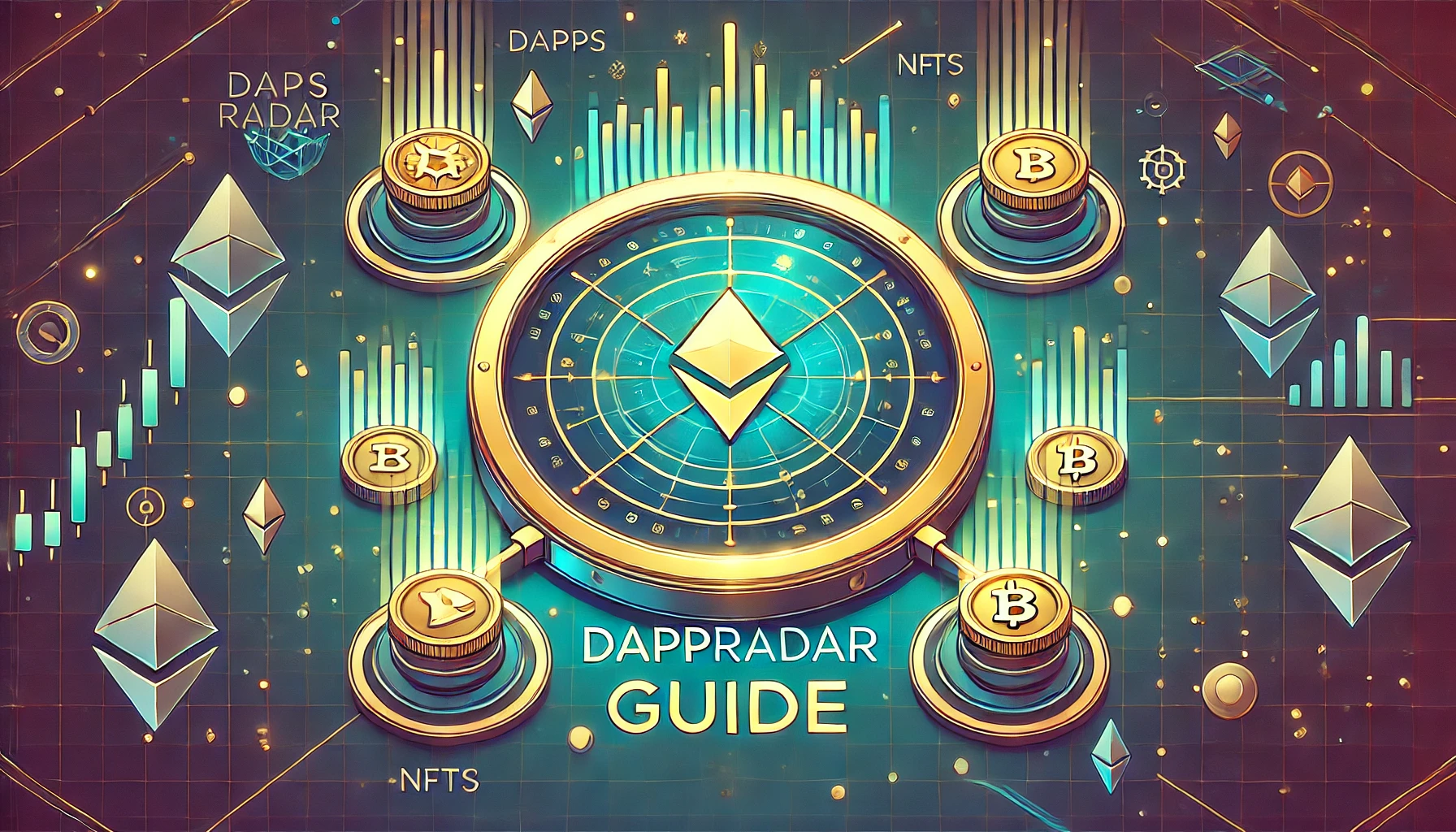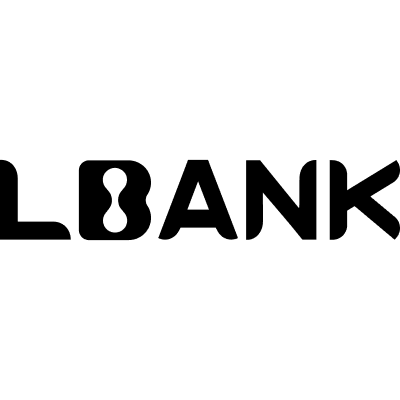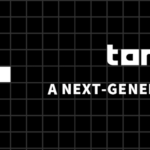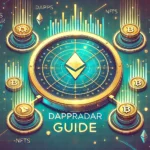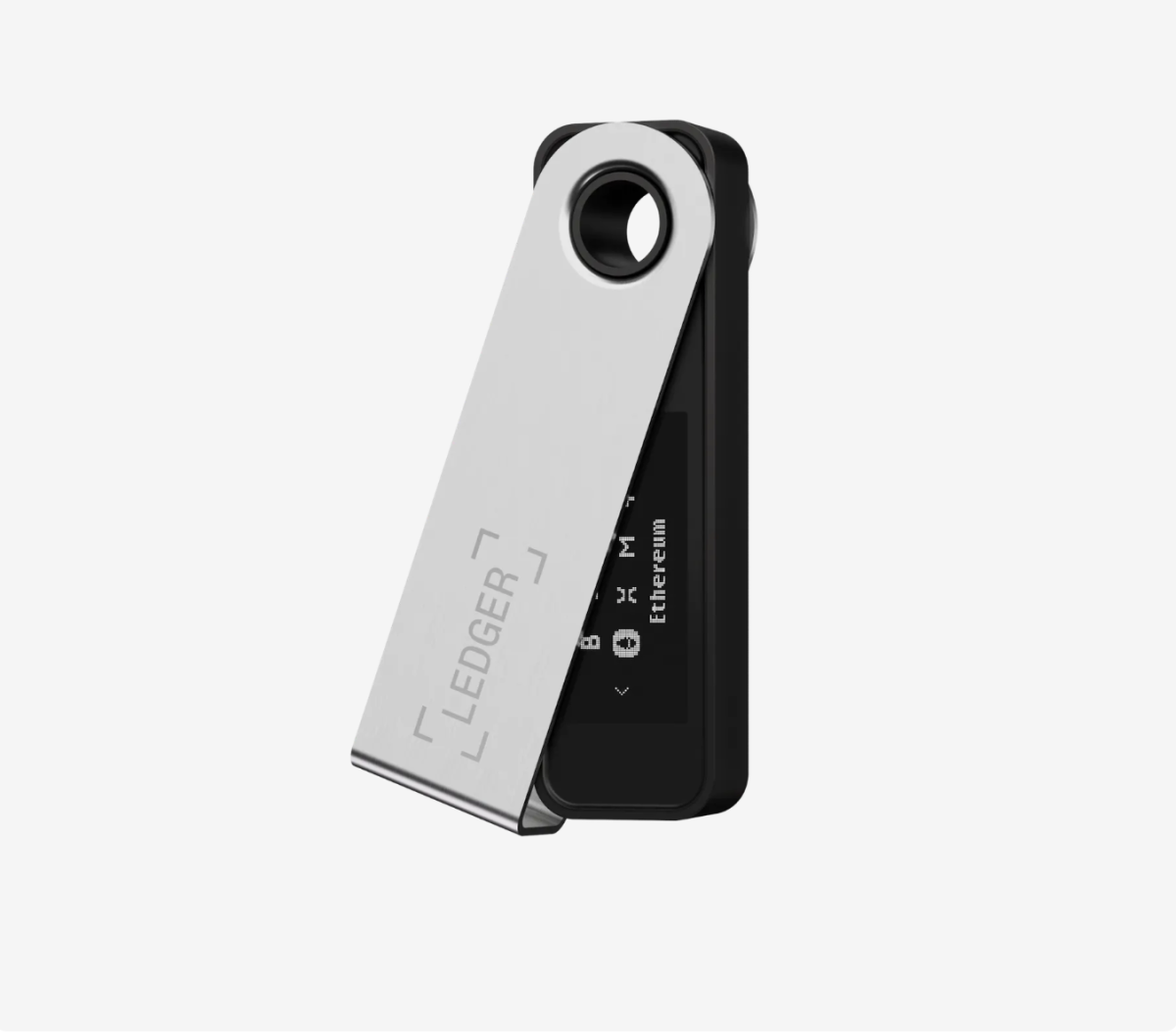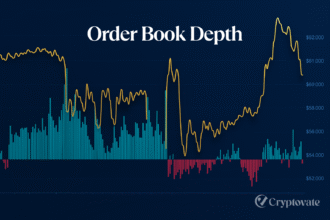– Ad –
| Getting your Trinity Audio player ready... |
DappRadar is your go-to platform for discovering, tracking, and analyzing decentralized applications (DApps) across various blockchain networks. Whether you’re a casual user, investor, developer, or business, DappRadar offers a comprehensive suite of tools to help you navigate the rapidly growing Web3 ecosystem. This guide will walk you through everything you need to know to make the most of DappRadar.
What is DappRadar?
DappRadar is a leading analytics platform and marketplace for decentralized applications (DApps) operating on various blockchain networks. Launched in 2018, DappRadar has become the go-to resource for anyone looking to explore, analyze, and interact with the growing world of Web3. Often referred to as the “App Store for DApps,” DappRadar provides users with real-time data, insights, and rankings of DApps across multiple categories, including decentralized finance (DeFi), gaming, non-fungible tokens (NFTs), and more.
As the Web3 ecosystem continues to expand, the need for reliable information and analytics has become increasingly important. DappRadar fills this gap by offering a comprehensive platform that aggregates and presents data on thousands of DApps, making it easier for users, investors, and developers to navigate the decentralized landscape. Whether you’re looking to discover a new DApp, monitor its performance, or manage your digital assets, DappRadar provides the tools and resources to do so efficiently.
Overview of DappRadar
DappRadar operates as a centralized platform within the decentralized world, offering a vast array of DApps from various blockchain networks such as Ethereum, Binance Smart Chain, Polygon, and others. It serves a diverse audience, including casual users exploring the Web3 space, serious investors analyzing market trends, and developers looking to showcase their projects.
The platform is known for its user-friendly interface and powerful analytics tools, which provide detailed insights into the performance of different DApps. This includes metrics like active user counts, transaction volumes, and total value locked (TVL), all of which are crucial for assessing the health and popularity of a DApp.
One of DappRadar’s strengths lies in its ability to provide real-time data across a wide range of DApps and blockchain networks. This enables users to stay updated with the latest trends and developments in the decentralized ecosystem. Additionally, DappRadar categorizes DApps into different sections based on their function and the blockchain they operate on, making it easier for users to find exactly what they’re looking for.
The platform also supports a community-driven approach, where users can contribute by sharing their experiences and insights about various DApps. This collective knowledge base helps to create a richer, more informed ecosystem where users can make better decisions and explore the Web3 world more effectively.
Key Features and Benefits
DappRadar offers a robust set of features that cater to different needs within the Web3 space. Here are some of the key features and benefits that make DappRadar an essential tool for anyone involved in the decentralized world:
1. Real-Time DApp Analytics
- Performance Metrics: DappRadar provides real-time data on DApps, including active users, transaction volumes, and TVL. These metrics are essential for understanding how a DApp is performing and gauging its popularity.
- Rankings: DappRadar ranks DApps based on various criteria, such as user activity and transaction volume, making it easy to identify top-performing DApps across different categories.
2. DApp Discovery
- Extensive Catalog: DappRadar hosts a vast catalog of DApps across multiple categories like DeFi, gaming, NFTs, and social platforms. Users can easily browse and discover new DApps tailored to their interests.
- Search and Filter Functions: Advanced search and filter options allow users to find specific DApps or explore new ones based on blockchain, category, or other criteria.
3. Portfolio Management
- Centralized Asset Tracking: DappRadar’s portfolio management feature lets users track their digital assets, including cryptocurrencies and NFTs, across multiple blockchain networks from one central location.
- Transaction History: Users can monitor their transaction history, giving them a clear view of their activity and helping them manage their assets more effectively.
4. Community and User Engagement
- User Reviews and Ratings: DappRadar allows users to leave reviews and ratings for DApps, providing valuable insights and feedback for the community.
- Community-Driven Insights: The platform fosters a community-driven environment where users can share tips, experiences, and knowledge, contributing to a more informed Web3 ecosystem.
5. Cross-Chain Support
- Multiple Blockchain Networks: DappRadar supports a wide range of blockchain networks, including Ethereum, Binance Smart Chain, Polygon, Tron, and more, allowing users to explore and interact with DApps across different ecosystems.
- Interoperability: The platform’s cross-chain capabilities make it easier for users to switch between different networks and manage their assets seamlessly.
6. RADAR Token and DappRadar Pro
- RADAR Token: DappRadar’s native cryptocurrency, RADAR, is used to unlock premium features and participate in platform governance. It can be staked for rewards and used to boost DApp visibility within the ecosystem.
- DappRadar Pro: Pro users gain access to exclusive insights, advanced analytics, and additional features, such as custom alerts and enhanced filtering options. This is particularly beneficial for power users and investors looking to gain a competitive edge.
7. Market Insights and Research
- In-Depth Reports: DappRadar provides comprehensive market insights and research reports that analyze trends, user behavior, and the overall health of the DApp ecosystem. This is invaluable for anyone looking to understand the broader market dynamics.
- News and Updates: The platform also offers a news section that keeps users informed about the latest developments in the decentralized world, including updates on popular DApps, blockchain networks, and industry events.
DappRadar stands out as a vital resource in the Web3 space, offering a combination of real-time analytics, extensive DApp discovery, and powerful portfolio management tools. Its ability to aggregate and present data across multiple blockchain networks makes it an indispensable platform for users, developers, and investors alike. Whether you’re looking to explore new DApps,, monitor their performance, or manage your digital assets, DappRadar provides the comprehensive tools and insights needed to navigate the decentralized world effectively.
How to Get Started with DappRadar
Getting started with DappRadar is a straightforward process that allows you to quickly access a wealth of information and tools for exploring decentralized applications (DApps). Whether you’re new to the platform or a seasoned Web3 user, this section will guide you through the essential steps to begin using DappRadar effectively.
Creating a DappRadar Account
Creating an account on DappRadar is the first step to unlocking its full potential. While some features are accessible without an account, having one allows you to save preferences, manage your portfolio, and access advanced tools.
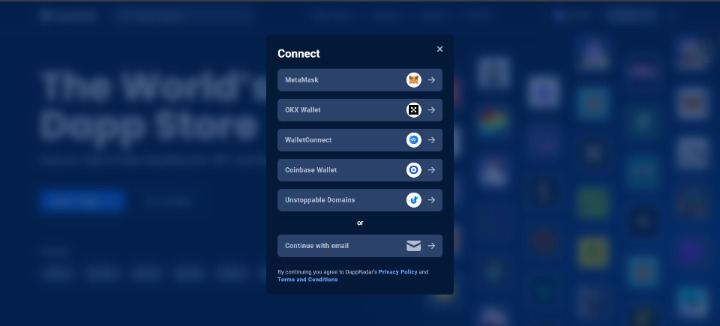
Steps to Create a DappRadar Account:
- Visit the DappRadar Website: Start by navigating to the official DappRadar website. You can do this on any modern web browser.
- Click on “Connect”: On the top right corner of the homepage, you will find the “Connect” button. Click on this to initiate the account creation process.
- Choose Your Sign-Up Method: DappRadar offers multiple sign-up methods to suit different preferences:
- Crypto Wallets: Connect using popular crypto wallets like MetaMask, OKX Wallet, or WalletConnect. This method is ideal for users who prefer to use their digital wallet as their primary login method.
- Social Media: Sign up using your social media accounts such as Facebook or Twitter (formerly known as X).
- Email: For those who prefer a more traditional approach, you can sign up using your email address.
- Enter Your Details: If you choose to sign up via email, you will be prompted to enter your email address and create a password. Ensure that your password is strong and secure.
- Verify Your Email: DappRadar will send a verification email to the address you provided. Check your inbox and click on the verification link to activate your account.
- Complete Your Profile: Once your account is verified, you may be asked to complete your profile by adding a username and profile picture. This step is optional but can enhance your user experience.
Connecting Your Wallet
Connecting a crypto wallet to DappRadar is crucial for accessing many of the platform’s advanced features, such as managing your portfolio, tracking your assets, and interacting with DApps directly.
Steps to Connect Your Wallet:
- Select a Supported Wallet: DappRadar supports a variety of crypto wallets, including MetaMask, Trust Wallet, WalletConnect, and more. Ensure you have one of these wallets set up with a balance before proceeding.
- Initiate Wallet Connection: After signing into your DappRadar account, click on the “Connect Wallet” option. This is usually found on the dashboard or in the top right corner near your profile icon.
- Authorize the Connection: Follow the prompts to authorize the connection between DappRadar and your wallet. This process will vary slightly depending on the wallet you use. For example, with MetaMask, you’ll receive a pop-up asking you to confirm the connection.
- Verify the Connection: Once connected, your wallet address should appear on your DappRadar account. You are now ready to explore DApps and manage your assets directly through the platform.
Note: To access DappRadar Pro features, ensure that your connected wallet contains the necessary RADAR tokens. This allows you to unlock advanced analytics, set custom alerts, and more.
Also Read: Top 10 dApps to Watch in 2025: Discover Trending Projects with DappRadar
Exploring the Dashboard
Once your account is set up and your wallet is connected, you can start exploring DappRadar’s comprehensive dashboard. The dashboard serves as the central hub where you can discover new DApps, track performance metrics, and manage your digital assets.
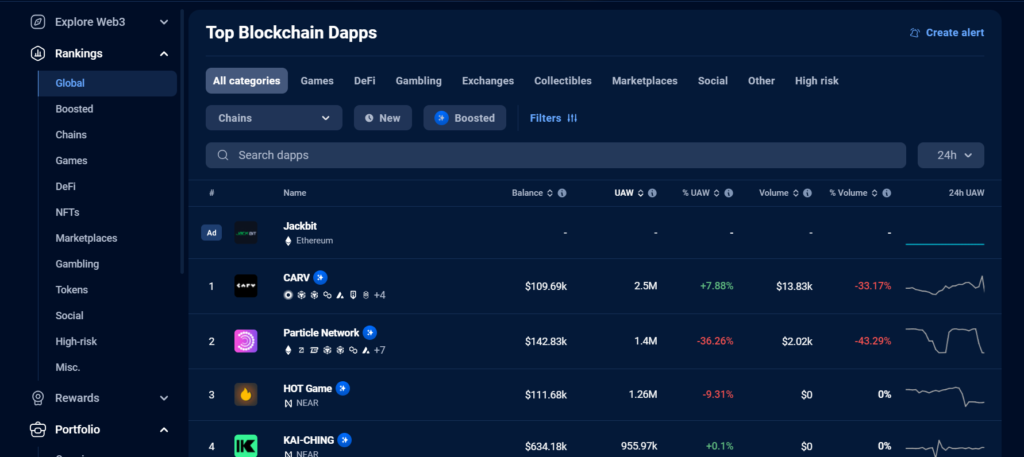
Navigating the DappRadar Dashboard:
- Overview of Top DApps: Upon logging in, you will be greeted by an overview of the top-performing DApps across various blockchain networks. This section provides quick insights into trending DApps based on metrics like active users, transaction volumes, and rankings.
- Sidebar Navigation: The left-hand sidebar is your primary navigation tool. It offers quick access to different sections, such as:
- Rankings: View the most popular DApps, sorted by categories like DeFi, games, and NFTs.
- Contracts: Explore smart contracts associated with various DApps.
- Games: Delve into the world of blockchain-based gaming with detailed analytics on top games.
- NFTs: Discover and analyze NFT collections across different networks.
- Search and Filter Functions: Use the search bar at the top to find specific DApps, tokens, or categories. Advanced filters allow you to narrow down results based on blockchain, category, and other criteria.
- Portfolio Section: The portfolio section on the dashboard provides a centralized view of your crypto holdings and NFTs. Here, you can track the performance of your assets, view transaction history, and manage your digital portfolio across multiple blockchains.
- Explore Section: This section allows you to discover new Web3 projects, including boosted and upcoming DApps. It’s a great way to stay ahead of trends and find potential investment opportunities.
- News and Research: Stay updated with the latest developments in the Web3 space through the news and research sections. These areas offer in-depth reports, industry news, and updates on your favorite DApps.
Navigating DappRadar’s Features
DappRadar is designed to be user-friendly, offering a wealth of tools and features to help users explore and interact with decentralized applications (DApps) effectively. Whether you’re new to the platform or a seasoned Web3 user, understanding how to navigate DappRadar’s features will significantly enhance your experience. This section covers how to explore DApps, use the platform’s search and filter functions, and access detailed DApp analytics.
Exploring DApps
DappRadar’s core functionality revolves around discovering and exploring a vast array of decentralized applications. The platform hosts thousands of DApps across multiple blockchain networks, making it a central hub for finding new and trending projects in the decentralized world.
How to Explore DApps:
- Access the DApp Catalog: Upon logging into DappRadar, the main dashboard will present you with an overview of top-performing DApps across different blockchains. This section is a great starting point for discovering popular DApps based on real-time data.
- Categories and Rankings: DappRadar categorizes DApps into various sections such as DeFi, gaming, NFTs, social, and high-risk. You can access these categories via the left-hand sidebar. Each category displays DApps ranked by metrics like active users, transaction volume, and total value locked (TVL), allowing you to quickly identify leading DApps in each sector.
- Blockchain Networks: DappRadar supports multiple blockchain networks including Ethereum, Binance Smart Chain, Polygon, Tron, and more. You can explore DApps specific to each network by selecting the desired blockchain from the sidebar. This is particularly useful if you are interested in projects operating on a specific blockchain.
- DApp Details: Clicking on any DApp within the catalog will take you to a detailed page where you can learn more about the DApp’s functionality, user engagement, and market performance. This page also provides links to the DApp’s official website, social media channels, and any relevant documentation.
- User Reviews and Ratings: DappRadar allows users to leave reviews and ratings for each DApp. These community-driven insights provide valuable feedback and can help you gauge the reliability and quality of a DApp before engaging with it.
Using Search and Filter Functions
DappRadar’s search and filter functions are powerful tools that help you find specific DApps or narrow down your options based on various criteria. Whether you’re looking for a particular type of DApp or want to explore new projects within a certain blockchain, these functions make your search process more efficient.
How to Use Search and Filter Functions:
- Search Bar: Located at the top of the DappRadar interface, the search bar is your primary tool for quickly finding specific DApps, tokens, or articles. Simply enter the name or keyword associated with what you’re looking for, and DappRadar will present a list of relevant results.
- Advanced Filters: For a more refined search, DappRadar offers advanced filtering options. These filters allow you to sort DApps based on criteria such as:
- Blockchain: Choose a specific blockchain like Ethereum, Binance Smart Chain, or Polygon.
- Category: Filter by categories such as DeFi, gaming, NFTs, or high-risk.
- User Activity: Filter DApps based on the number of active users or transaction volumes.
- Ranking and Performance Metrics: Sort DApps by metrics like TVL, market cap, or user ratings.
- Sorting Options: You can also sort search results by popularity, recently added, or top-performing DApps. This helps you discover trending DApps or focus on the latest additions to the DappRadar catalog.
- Combining Filters: One of the strengths of DappRadar’s search function is the ability to combine multiple filters. For example, you can search for DeFi DApps on the Ethereum network with the highest transaction volumes. This granular search capability is particularly useful for investors and users looking to pinpoint specific opportunities.
Accessing Detailed DApp Analytics
DappRadar goes beyond simple discovery by providing in-depth analytics for each DApp listed on the platform. These analytics are crucial for understanding the performance, popularity, and economic activity of a DApp, allowing users to make informed decisions.
How to Access Detailed DApp Analytics:
- DApp Overview Page: Once you click on a DApp from the catalog or search results, you’ll be directed to its detailed overview page. This page provides a comprehensive summary of the DApp, including its purpose, blockchain network, and key metrics.
- Key Performance Metrics: The overview page highlights essential performance metrics such as:
- Active Users: The number of unique active wallets (UAWs) interacting with the DApp’s smart contracts. This metric gives you an idea of the DApp’s user base and engagement level.
- Transaction Volume: The total value of transactions conducted within the DApp over a specified period. This metric helps gauge the economic activity within the DApp.
- Total Value Locked (TVL): The total dollar value of assets currently locked within the DApp’s smart contracts. TVL is a critical metric for DeFi DApps as it reflects the trust and investment users place in the platform.
- Market Performance: For some DApps, DappRadar also provides data on market performance, such as price trends and trading volumes for associated tokens.
- Historical Data: DappRadar allows you to view historical data for each DApp, showing how metrics like active users, transaction volumes, and TVL have evolved over time. This historical perspective is useful for spotting trends and understanding the long-term performance of a DApp.
- User Reviews and Ratings: In addition to quantitative data, DappRadar’s analytics also include qualitative insights from user reviews and ratings. These can provide a more nuanced understanding of the DApp’s reputation and user satisfaction.
- Comparative Analytics: DappRadar enables you to compare different DApps side by side, making it easier to evaluate and contrast their performance. This is particularly useful for investors and researchers looking to analyze multiple DApps within the same category or across different blockchains.
Tracking DApp Performance
Monitoring the performance of decentralized applications (DApps) is crucial for understanding their impact, popularity, and potential investment value. DappRadar provides users with a suite of tools to track DApp performance effectively. This includes real-time data, detailed analytics, and ranking features that give you insights into how well a DApp is performing in the ever-evolving Web3 space.
Using DappRadar’s Ranking Features
DappRadar’s ranking system is one of its most valuable features, allowing you to quickly identify top-performing DApps across various categories and blockchain networks. The rankings are based on several key metrics, providing a comprehensive overview of a DApp’s standing in the decentralized ecosystem.
How to Use DappRadar’s Ranking Features:
- Accessing Rankings: From the DappRadar dashboard, navigate to the “Rankings” section using the left-hand sidebar. Here, you can view lists of DApps sorted by categories such as DeFi, gaming, NFTs, and more. Each category provides a ranking of DApps based on their performance metrics.
- Sorting and Filtering: DappRadar allows you to sort DApp rankings by specific criteria, such as most active users, highest transaction volumes, or top TVL (Total Value Locked). You can also filter rankings by blockchain network, making it easy to focus on DApps within a particular ecosystem like Ethereum or Binance Smart Chain.
- Detailed Rankings Page: Clicking on a specific DApp in the rankings list will take you to its detailed page, where you can explore more in-depth analytics. This includes historical performance data, user engagement statistics, and other key indicators.
Key Metrics to Monitor
To effectively track the performance of a DApp, it’s essential to focus on a few key metrics that offer valuable insights into its activity and user engagement. The most important metrics to monitor on DappRadar include:
1. Active Users
- Definition: Active users refer to the number of unique wallets interacting with a DApp over a specific period, typically measured daily or monthly.
- Why It Matters: High active user counts indicate strong user engagement and adoption, suggesting that the DApp is popular and has a loyal user base. This metric is particularly useful for identifying which DApps are attracting the most attention in the Web3 space.
2. Transaction Volumes
- Definition: Transaction volume represents the total value of transactions conducted within a DApp, measured in the native cryptocurrency of the blockchain it’s operating on (e.g., ETH for Ethereum-based DApps).
- Why It Matters: High transaction volumes suggest that a significant amount of economic activity is taking place within the DApp. This can be a sign of the DApp’s financial health and its ability to generate value for its users. For DeFi DApps, in particular, transaction volume is a key indicator of liquidity and user trust.
3. Total Value Locked (TVL)
- Definition: TVL refers to the total value of assets locked within a DApp’s smart contracts. It is a critical metric, especially for DeFi applications, as it indicates the amount of capital being staked or invested in the platform.
- Why It Matters: A high TVL suggests that users have confidence in the DApp and are willing to commit significant assets to it. This metric is often used to measure the overall security and trustworthiness of a DeFi platform. It also gives insights into the DApp’s market share within its category.
Analyzing DApp Popularity and Performance
Analyzing the popularity and performance of a DApp involves looking at a combination of the key metrics mentioned above and understanding the context in which they exist. By doing so, you can gain a deeper insight into the DApp’s potential for growth, user satisfaction, and overall impact in the decentralized ecosystem.
Steps to Analyze DApp Popularity and Performance:
- Compare Metrics Across Time: Use DappRadar’s historical data feature to track how a DApp’s metrics have evolved over time. A steady increase in active users, transaction volumes, and TVL typically indicates growing popularity and trust in the platform.
- Evaluate User Engagement: Consider how actively users are engaging with the DApp. For instance, a DApp with high transaction volumes but low active users might indicate that a few users are responsible for most of the activity. Conversely, high active users with modest transaction volumes might suggest broad but shallow engagement.
- Look at Market Context: Compare the DApp’s performance metrics with those of its competitors within the same category or blockchain. This helps you assess whether the DApp is leading the market or if it’s lagging behind similar projects.
- Consider User Reviews and Ratings: DappRadar’s user reviews and ratings provide qualitative insights that complement the quantitative data. Positive reviews and high ratings often correlate with strong performance metrics, while negative feedback might indicate underlying issues.
- Monitor for Sudden Changes: Be alert to any sudden spikes or drops in key metrics. These could be signs of significant events such as a major upgrade, security breach, or changes in market conditions. Understanding the cause of these fluctuations can help you make more informed decisions.
Tracking DApp performance on DappRadar is essential for anyone looking to stay informed and make data-driven decisions in the decentralized space. By using DappRadar’s ranking features and monitoring key metrics such as active users, transaction volumes, and TVL, you can gain a comprehensive understanding of a DApp’s popularity, financial health, and potential for future growth. Whether you’re an investor, developer, or casual user, these insights are invaluable for navigating the rapidly evolving world of Web3.
Managing Your Portfolio on DappRadar
DappRadar isn’t just a platform for discovering and analyzing decentralized applications (DApps); it also offers robust tools for managing your cryptocurrency portfolio. With DappRadar’s Portfolio Tracker, you can keep a close eye on your crypto assets and non-fungible tokens (NFTs), all from one centralized dashboard. This guide will walk you through how to effectively use DappRadar’s Portfolio Tracker, view and manage your digital assets, and monitor your transaction history.
How to Use the Portfolio Tracker
The Portfolio Tracker on DappRadar is designed to provide you with a clear overview of your digital assets across various blockchain networks. It consolidates all your holdings into one easy-to-navigate interface, making it easier to manage and track your investments.
Steps to Use the Portfolio Tracker:
- Connect Your Wallet: Before you can use the Portfolio Tracker, you need to connect your cryptocurrency wallet to DappRadar. Supported wallets include MetaMask, Trust Wallet, and others. Once connected, DappRadar will automatically pull in data from your wallet to populate your portfolio.
- Access the Portfolio Section: After connecting your wallet, navigate to the “Portfolio” section from the DappRadar dashboard. This section provides a summary of all your assets, including cryptocurrencies, NFTs, and any tokens you may have staked or invested in.
- View Asset Breakdown: The Portfolio Tracker displays your holdings in a clear, organized manner. You’ll see a breakdown of your assets by type, blockchain network, and value. This makes it easy to understand where your investments are concentrated and how they are performing.
- Track Multiple Wallets: If you manage multiple wallets, you can link them all to DappRadar. The Portfolio Tracker will then aggregate the data, giving you a comprehensive view of your entire crypto portfolio in one place.
- Monitor Real-Time Values: The Portfolio Tracker updates in real-time, showing the current market value of your assets. This feature is particularly useful for keeping track of how your portfolio is performing as market conditions change.
Viewing and Managing Your Crypto Assets and NFTs
One of the key features of DappRadar’s Portfolio Tracker is its ability to manage both your crypto assets and NFTs. This integration allows you to oversee all your digital holdings without needing to switch between different platforms.
Viewing and Managing Crypto Assets:
- Detailed Asset View: The Portfolio Tracker provides detailed information about each cryptocurrency in your wallet, including its current market value, the amount you hold, and its historical price trends. This helps you make informed decisions about when to hold, sell, or buy more of a particular asset.
- Token Performance: For each token in your portfolio, DappRadar shows performance metrics like price changes over time, market capitalization, and trading volumes. These insights are crucial for evaluating the potential growth or risk associated with your holdings.
- Staked Assets: If you have assets staked in DeFi protocols or other platforms, DappRadar will track these as well. You can see the staked amount, the platform it’s staked on, and the rewards you’re earning, all within the Portfolio Tracker.
Viewing and Managing NFTs:
- NFT Collection Overview: DappRadar makes it easy to view and manage your NFTs by displaying them alongside your other crypto assets. You can see the total value of your NFT collection, as well as details about individual NFTs, such as their current market value, rarity, and historical sales data.
- Marketplace Integration: If you decide to sell or trade your NFTs, DappRadar provides links to the most popular NFT marketplaces where you can list your items. This integration streamlines the process of managing and monetizing your NFT collection.
- NFT Performance Metrics: Just like with cryptocurrencies, DappRadar offers performance metrics for your NFTs. You can track the price history of each NFT, see how the value of your collection has changed over time, and identify trends that might influence future sales.
Monitoring Transaction History
Keeping track of your transaction history is essential for effective portfolio management. DappRadar’s Portfolio Tracker includes a feature that allows you to view and analyze all your past transactions in one place.
How to Monitor Transaction History:
- Access Transaction History: In the Portfolio Tracker, there is a dedicated section for transaction history. Here, you can see a log of all the transactions made through your connected wallets, including transfers, trades, and staking activities.
- Transaction Details: Each transaction entry provides detailed information, such as the date and time of the transaction, the type of transaction (e.g., buy, sell, stake), the assets involved, and the transaction fees. This transparency helps you understand your investment moves better.
- Filter and Search: DappRadar allows you to filter your transaction history by date range, asset type, or transaction type. This makes it easy to find specific transactions, especially when you need to review your investment decisions or prepare for tax reporting.
- Analyze Transaction Trends: By reviewing your transaction history, you can identify patterns in your trading behavior, such as frequently traded assets or periods of high activity. This analysis can help you refine your investment strategy and optimize future transactions.
DappRadar’s Portfolio Tracker is an indispensable tool for anyone looking to manage their crypto assets and NFTs efficiently. By providing a centralized platform to view your holdings, track asset performance, and monitor transaction history, DappRadar simplifies the complexities of portfolio management in the decentralized world. Whether you’re an investor, trader, or NFT collector, the Portfolio Tracker offers the insights and tools needed to stay on top of your digital investments.
Understanding RADAR Token
The RADAR token is the native cryptocurrency of the DappRadar ecosystem, playing a crucial role in enhancing the platform’s functionality and offering users a range of benefits. As DappRadar continues to expand its influence in the decentralized application (DApp) space, the RADAR token has become an essential component for users looking to access premium features, participate in governance, and earn rewards through staking.
Overview of RADAR Token
The RADAR token was introduced as a utility token to support the DappRadar platform’s growth and development. It operates on multiple blockchain networks, including Ethereum and Binance Smart Chain (BSC), making it accessible to a wide audience. The token is designed to empower users within the DappRadar ecosystem, offering them access to advanced tools, data, and services that go beyond the platform’s standard offerings.
RADAR tokens serve several purposes within the DappRadar ecosystem:
- Access to Premium Features: Holding a certain amount of RADAR tokens unlocks DappRadar Pro, a premium tier of the platform that offers exclusive data, insights, and tools.
- Governance: RADAR token holders can participate in the governance of the DappRadar platform by voting on proposals that affect the platform’s future development and direction.
- Staking: Users can stake their RADAR tokens to earn rewards, contributing to the security and stability of the DappRadar ecosystem.
The RADAR token’s multi-functional nature makes it a valuable asset for anyone deeply involved in the Web3 space, particularly those who frequently use DappRadar for tracking, managing, and investing in DApps.
Also Read: A Comprehensive Guide to Understanding Crypto Staking: Everything You Need to Know
Benefits for DappRadar Pro Users
DappRadar offers a free version with basic features, but for those looking to access more advanced tools and data, upgrading to DappRadar Pro is highly beneficial. DappRadar Pro is an enhanced version of the platform, unlocked by holding a specific amount of RADAR tokens.
Key Benefits of DappRadar Pro:
- Exclusive Insights and Data: DappRadar Pro users gain access to in-depth research reports, exclusive analytics, and detailed data that are not available to standard users. This information can provide a competitive edge, especially for investors and developers looking to stay ahead in the DApp space.
- Advanced Filtering and Search: With DappRadar Pro, users can take advantage of advanced filtering options that allow them to pinpoint specific DApps, tokens, or trends within the ecosystem. This feature is particularly useful for those who need to conduct thorough research or analysis.
- Custom Alerts: Pro users can set up personalized alerts for various metrics across multiple chains and categories. These alerts help users stay informed about important developments in the DApp ecosystem without needing to constantly monitor the platform.
- Higher Staking Rewards: DappRadar Pro members who stake their RADAR tokens can earn higher rewards, making it a more lucrative option for those who actively participate in the DappRadar ecosystem.
- Access to Exclusive Airdrops and Quests: Pro users are eligible for exclusive airdrops and participation in special quests that are not available to standard users. These events provide additional opportunities to earn rewards and engage with new projects.
By upgrading to DappRadar Pro, users can significantly enhance their experience on the platform, gaining deeper insights and access to tools that can help them make more informed decisions in the Web3 space.
Staking and Governance Features
Staking and governance are two critical features of the RADAR token that provide users with additional benefits and opportunities to influence the DappRadar platform.

Staking RADAR Tokens:
- Earning Rewards: By staking RADAR tokens, users can earn staking rewards, typically in the form of additional RADAR tokens. The staking process involves locking a certain amount of tokens in the platform’s smart contracts for a specific period, during which users earn rewards based on the number of tokens staked and the duration of the stake.
- Support for the Ecosystem: Staking contributes to the overall stability and security of the DappRadar ecosystem. It encourages long-term commitment from users and helps to reduce the circulating supply of RADAR tokens, which can have a positive impact on the token’s value.
- Flexible Staking Options: DappRadar offers flexible staking options, allowing users to choose from different staking pools or durations based on their preferences and risk tolerance. This flexibility ensures that users can find a staking strategy that aligns with their investment goals.
Governance Participation:
- Voting Rights: RADAR token holders have the ability to participate in the governance of the DappRadar platform by voting on key proposals. These proposals can range from platform upgrades and new feature implementations to changes in tokenomics and other important decisions.
- Influence on Platform Development: By participating in governance, RADAR token holders can directly influence the future direction of DappRadar. This decentralized approach to decision-making ensures that the platform evolves in a way that reflects the interests and needs of its user community.
- Engagement in the Community: Governance participation also fosters a sense of community among RADAR token holders, as they collaborate and debate on proposals that shape the platform. This active engagement is crucial for the long-term success and sustainability of the DappRadar ecosystem.
The RADAR token is a key element of the DappRadar ecosystem, offering users a range of benefits, from accessing premium features to participating in platform governance. Whether you’re interested in unlocking advanced tools with DappRadar Pro, earning rewards through staking, or having a say in the platform’s development, the RADAR token provides valuable opportunities to enhance your experience on DappRadar. As the Web3 space continues to grow, holding and utilizing RADAR tokens can offer significant advantages for users looking to make the most of their interactions with decentralized applications.
Is DappRadar Pro Worth It?
DappRadar Pro offers an enhanced experience for users who want deeper insights, advanced tools, and exclusive access to the latest trends in decentralized applications (DApps) and the broader Web3 ecosystem. But is it worth the investment? In this guide, we’ll explore the features of DappRadar Pro, weigh the pros and cons of upgrading, and walk you through how to activate the Pro version.
Features of DappRadar Pro
DappRadar Pro unlocks a suite of premium features designed to give users a competitive edge in the rapidly evolving world of DApps and decentralized finance (DeFi). Here’s what you get with a DappRadar Pro subscription:
1. Exclusive Data and Insights
- In-Depth Analytics: Pro users gain access to detailed analytics and research reports that are not available to standard users. This includes data on emerging trends, market movements, and performance metrics for top DApps.
- Advanced Metrics: Dive deeper into DApp performance with advanced metrics like historical trends, user retention rates, and in-depth comparisons across different blockchain networks.
2. Advanced Filtering and Search
- Enhanced Search Tools: Pro users can utilize advanced search filters to pinpoint specific DApps, tokens, or blockchain projects. These tools are especially useful for investors and researchers looking to discover opportunities that meet precise criteria.
- Customizable Filters: Tailor your search results with customizable filters that allow you to combine different criteria, such as blockchain network, user activity, and transaction volume.
3. Custom Alerts
- Personalized Notifications: Set up custom alerts for specific DApps, tokens, or metrics. These alerts can notify you of significant changes, such as price fluctuations, spikes in user activity, or new DApp launches, ensuring you never miss critical updates.
4. Higher Staking Rewards
- Increased Returns: DappRadar Pro users who stake RADAR tokens are eligible for higher staking rewards compared to standard users. This feature makes Pro membership more appealing for those looking to maximize their returns within the DappRadar ecosystem.
5. Access to Exclusive Airdrops and Quests
- Special Events: Pro members get access to exclusive airdrops and quests that are not available to the general user base. Participating in these events can provide additional rewards and early access to new projects.
Pros and Cons of Upgrading to Pro
While DappRadar Pro offers a range of powerful features, it’s important to weigh the pros and cons to determine if the upgrade is right for you.
Pros:
- Comprehensive Data Access: Pro users benefit from access to exclusive data and advanced analytics, which are crucial for making informed decisions in the fast-paced world of DApps and DeFi.
- Custom Alerts: The ability to set personalized alerts means you can stay on top of important developments without needing to constantly monitor the platform.
- Higher Staking Rewards: The potential for increased staking rewards makes Pro membership financially appealing, especially for active participants in the DappRadar ecosystem.
- Exclusive Opportunities: Access to special airdrops, quests, and other events gives Pro members unique opportunities to earn rewards and engage with new projects early.
Cons:
- Cost of Entry: Activating DappRadar Pro requires holding a specific amount of RADAR tokens, which could be a barrier for some users, especially those new to the platform or with limited investment capital.
- Commitment: Staking RADAR tokens to access Pro features involves a commitment, including a 30-day unstaking cooldown period, which might not be ideal for users who prefer flexibility in managing their assets.
- Advanced Features Might Be Overkill: For casual users who do not need in-depth analytics or advanced tools, the standard version of DappRadar might suffice, making the Pro features unnecessary.
How to Activate DappRadar Pro
Activating DappRadar Pro is a straightforward process, but it does require holding a certain amount of RADAR tokens. Here’s how to get started:
Steps to Activate DappRadar Pro:
- Acquire RADAR Tokens: First, you’ll need to purchase RADAR tokens. These can be bought on various cryptocurrency exchanges such as Uniswap, SushiSwap, or any other platform where RADAR is listed. Make sure to transfer your tokens to a compatible wallet (like MetaMask) that you can connect to DappRadar.
- Connect Your Wallet: Visit the DappRadar website and connect your wallet by clicking on the “Connect” button at the top right of the homepage. Ensure your wallet contains the necessary RADAR tokens required to activate Pro.
- Stake RADAR Tokens: Once your wallet is connected, navigate to the staking section. You will need to stake the required amount of RADAR tokens to unlock DappRadar Pro. Follow the on-screen instructions to complete the staking process.
- Access Pro Features: After staking your RADAR tokens, DappRadar Pro features will be unlocked automatically. You can now access advanced analytics, set custom alerts, and enjoy all the other benefits of Pro membership.
- Manage Your Pro Membership: Keep track of your staking rewards and monitor the unstaking cooldown period if you decide to withdraw your tokens. Remember, the longer you stake, the more rewards you can potentially earn.
DappRadar Pro is an excellent upgrade for users who need advanced tools, deeper insights, and exclusive access to the latest developments in the DApp and Web3 ecosystem. While the cost and commitment required to activate Pro might not be suitable for everyone, the benefits, including higher staking rewards, custom alerts, and in-depth data, make it a worthwhile investment for serious users, investors, and developers.
Conclusion
DappRadar has established itself as a leading platform in the Web3 ecosystem, providing essential tools and insights for anyone interested in decentralized applications (DApps). Whether you are a casual user, investor, or developer, DappRadar offers a comprehensive suite of features that cater to your specific needs. From discovering new DApps and tracking their performance to managing your crypto assets and NFTs, DappRadar simplifies the complexities of the decentralized world.
Upgrading to DappRadar Pro unlocks even more advanced tools and exclusive data, making it a valuable investment for those who want to stay ahead in the rapidly evolving DApp landscape. With features like custom alerts, enhanced analytics, and higher staking rewards, DappRadar Pro empowers users to make informed decisions and maximize their participation in the Web3 ecosystem.
In conclusion, DappRadar is more than just a platform for exploring DApps—it is a powerful resource that enhances your ability to navigate and succeed in the decentralized world. Whether you choose to use the free version or upgrade to Pro, DappRadar provides the insights and tools you need to thrive in the blockchain era.
FAQs
What is DappRadar, and how does it work?
DappRadar is a leading platform for discovering, analyzing, and tracking decentralized applications (DApps) across various blockchain networks. It provides real-time data on DApp performance, including active users, transaction volumes, and total value locked (TVL), helping users make informed decisions about which DApps to use, invest in, or monitor.
What is the RADAR token, and what is it used for?
The RADAR token is the native cryptocurrency of the DappRadar platform. It is used to unlock DappRadar Pro features, participate in platform governance, and earn rewards through staking. Holding RADAR tokens gives users access to exclusive data, advanced analytics, and other premium features within the DappRadar ecosystem.
How do I activate DappRadar Pro, and what are the benefits?
To activate DappRadar Pro, you need to hold and stake a specific amount of RADAR tokens in your connected crypto wallet. Benefits of DappRadar Pro include access to in-depth analytics, advanced filtering options, custom alerts, higher staking rewards, and participation in exclusive airdrops and quests.
Can I track my cryptocurrency and NFTs on DappRadar?
Yes, DappRadar’s Portfolio Tracker allows you to track and manage your cryptocurrency and NFT assets across multiple blockchain networks. You can view the current value of your holdings, monitor transaction history, and get detailed insights into the performance of your digital assets.
What are the key metrics to monitor when evaluating a DApp on DappRadar?
The most important metrics to monitor include active users (the number of unique wallets interacting with the DApp), transaction volumes (the total value of transactions conducted within the DApp), and total value locked (TVL, which represents the amount of assets staked or invested in the DApp). These metrics provide a comprehensive view of a DApp’s popularity and financial health.
Is DappRadar free to use, or are there paid features?
DappRadar offers a free version with access to basic features and data. However, to unlock advanced features like detailed analytics, custom alerts, and higher staking rewards, users can upgrade to DappRadar Pro by holding and staking RADAR tokens.
How does DappRadar compare DApps across different blockchains?
DappRadar supports multiple blockchain networks, including Ethereum, Binance Smart Chain, and Polygon, among others. The platform allows users to compare DApps across these networks using various metrics such as active users, transaction volumes, and TVL. This cross-chain comparison helps users identify top-performing DApps regardless of the blockchain they operate on.


